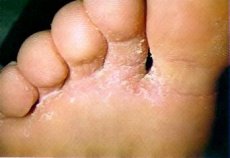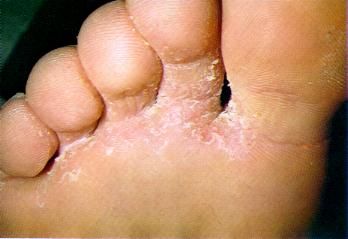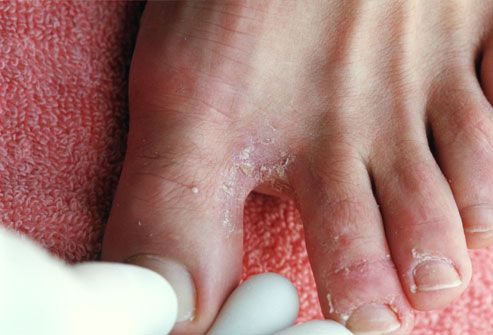Medical expert of the article
New publications
What is athlete's foot or mycosis?
Last reviewed: 05.07.2025

All iLive content is medically reviewed or fact checked to ensure as much factual accuracy as possible.
We have strict sourcing guidelines and only link to reputable media sites, academic research institutions and, whenever possible, medically peer reviewed studies. Note that the numbers in parentheses ([1], [2], etc.) are clickable links to these studies.
If you feel that any of our content is inaccurate, out-of-date, or otherwise questionable, please select it and press Ctrl + Enter.

More than 350 million men and women worldwide suffer from mycoses. More than 300 million men and women of them are subject to mycosis of the feet, this disease is also called athlete's foot or epidermophytosis of the foot. It was given this name because athletes suffer from it most often. What causes this disease and why can you get infected with it? How to avoid it? The answers to these questions are on our pages.

What is athlete's foot?
Athlete's foot is a very common skin condition that affects the soles of the feet and the skin between the toes. Typically, scaly, red, itchy rashes develop on the foot. This affects athlete's foot. Although it is often a result of a fungal infection, other causes may be identified without proper testing.
There are many fungi that cause athlete's foot, including gyms, locker rooms, swimming pools, nail salons, airport security lines, and wearing contaminated socks and clothing. Fungi can also be spread directly from person to person by contact. Most people get athlete's foot by walking barefoot in areas where someone with athlete's foot has been.
Some people are more prone to this condition, while others are relatively resistant to it. Another cause of athlete's foot may be tropical climates where members of the military work.
However, without the proper environment (warm, moist environment), the fungus cannot easily infect the skin. Up to 70% of the population will get athlete's foot at some point in their lives. Fungal infection does not give a person any resistance to subsequent infections.
Mycosis statistics
Statistics on mycosis infection show that 67% of people become infected with fungus in saunas, gyms and when visiting a bathhouse, 30% of people can get "athlete's foot" due to tight shoes, and 40% - due to increased sweating of the feet. When people put on someone else's shoes and socks, they are susceptible to mycosis in 70% of cases. These percentages can be combined, so people become infected with mycosis due to complex reasons.
Even if a person is careful and uses protection in public places such as a bathhouse and sauna, or a swimming pool, he can get athlete's foot due to a wound on the foot through which a small flake of someone else's skin infected with mycosis or a small piece of an infected nail has penetrated. This can happen in a pedicure salon if they do not follow basic hygiene rules and do not disinfect the tools properly.
Is mycosis contagious?
Athlete's foot can be contagious, and the condition can be passed from person to person. Some people may be more susceptible to the fungus that occurs on the foot, while others are more resistant to athlete's foot. There are many families where two people (such as a husband and wife, siblings) use the same shower and bathroom for many years and do not catch the fungus from each other. The exact cause of this predisposition or susceptibility to fungal infections is unknown. Athlete's foot is more contagious in moist, warm environments.
Fungus concentration
The fungus that causes mycosis lurks in showers of swimming pools, on the floors of locker rooms, in saunas and baths, which are visited not only by professional athletes, but also by people who lead a healthy lifestyle. That is why each of us is susceptible to mycosis, or a disease called athlete's foot, without even suspecting it.
Conditions for infection with fungus are not only damp floors of locker rooms and showers, but also tight damp shoes, dirty socks, and the disease is contagious. Research shows that 22 people out of a hundred have no idea that mycosis can be contracted in public places and that this disease tends to be transmitted by contact with an infected surface.
Mycosis is also called athlete's foot, which is characterized by a rash on the foot caused by a fungus.
 [ 1 ], [ 2 ], [ 3 ], [ 4 ], [ 5 ]
[ 1 ], [ 2 ], [ 3 ], [ 4 ], [ 5 ]
What else causes foot rashes?
There are many possible causes of foot rashes. Additional causes include irritant or contact dermatitis, allergic rashes from shoes or chemical creams, dyshidrotic eczema (an allergic skin rash), psoriasis, fungal infections, and bacterial infections.
A dermatologist can perform a simple test that uses potassium hydroxide for microscopic fungal examination, which is done in the office or lab to confirm the presence of a fungal infection. This test is done using a small skin scraping that is examined under a microscope.
Many dermatologists can perform this test in their office, with results available within minutes. Sometimes a small piece of skin may be scraped off and sent for a biopsy to confirm the diagnosis.
What are the symptoms and signs of athlete's foot?
Many people with athlete's foot experience no symptoms at all and don't even know they have an infection. Many may think they just have dry skin on the soles of their feet. Common symptoms of athlete's foot typically include varying degrees of itching and burning. The skin may peel frequently and, in severe cases, may develop multiple cracks, pain, and bleeding.
What does mycosis look like?
Most cases of athlete's foot are barely noticeable, with just a little dry, flaky skin on the foot. Athlete's foot may also appear as red, flaky, dry patches of skin on one or both feet. Sometimes the dry flakes may spread to both sides and the top of the foot. Most often, the rash is localized only to the bottom of the foot. The area between the fourth and fifth toes may also have some increased moisture, scales, and dry flakes of skin.
There are three general types of athlete's feet.
- Too hard soles of the feet, like moccasins
- Scales between the fingers, like "interdigital" scales
- Inflammatory skin type or blisters on the foot
Rare cases of athlete's foot
Unusual cases of athlete's foot may appear as small or large blisters on the feet (called bullous dermatophilia pedis), thick patches of dry, red skin, calluses, and redness. Sometimes it may appear as soft, dry skin without redness or inflammation.
Athlete's foot can appear as a rash on one or both feet and can even include a rash on the hands. Athlete's foot is a very common foot condition, especially in men. Types of fungal infections can be called tinea. The exact reason why the infection usually affects only one side of the foot is unknown.
Mycosis can also be considered together with ringworm, which is localized in the groin area (especially in men). It is useful to diagnose the foot when there is a fungal rash in the groin, the so-called inguinal dermatomycosis. It is important to treat all areas of fungal infection very carefully to avoid re-infection. Treating the soles and ignoring fungal nail infections can lead to relapses of athlete's foot. It is important to evaluate all potential sources of fungal infection and carry out disease prevention.
How can I treat athlete's foot during pregnancy?
Treatment options during pregnancy may include diluted vinegar soaks or sprays (approximately one part household vinegar to four parts water) and Lotrimin cream twice daily for two to three weeks to the soles. Antifungal tablets are generally not recommended during pregnancy due to possible side effects and possible fetal harm. Always check with your obstetrician/gynecologist before using any medication or treatment during pregnancy.
Athlete's foot during pregnancy
If you notice redness, swelling, bleeding on your foot during pregnancy, or if the infection does not go away, see a dermatologist. If it is a bacterial infection, antibiotic tablets may help. If you have fungal nail infections during pregnancy, diabetes, or have a compromised immune system, you should definitely consult a dermatologist for treatment.
What are the possible complications of athlete's foot?

Untreated nails, feet can be affected by fungal diseases due to poor hygiene. These diseases can potentially spread to other parts of the body or other people, including family members. Fungus can spread locally to the feet, nails, hands, and almost any part of the body.
This type of fungus generally likes to live in the skin, hair and nails. It does not invade deeply into the body's organs or the bloodstream.
Fungal nail infections are called tinea unguium or onychomycosis. Nail fungus is very difficult to treat. Antifungal tablets may be needed for more severe fungal infections.
- Fungal nail infections (onychomycosis)
- Groin fungus (groin dermatomycosis)
- Fungus on the skin (dermatomycosis)
- Secondary bacterial infection
People with diabetes, HIV/AIDS, cancer, or other immune problems may be more prone to all kinds of infections, including fungi.
When the skin is damaged by fungus, the skin's natural protective barrier is compromised. Bacteria and yeast can enter the damaged skin. Bacteria can cause an unpleasant odor. Bacterial skin infections resulting from inflammation are known as cellulitis. This is especially likely to occur in people with diabetes, chronic swelling of the legs, those from which some veins have been removed (for example, due to thrombosis or varicose veins), or in older people. Bacterial skin infections are also more common in patients with compromised immune systems.
What is Athlete's Foot Treatment?
Foot treatment can be divided into two parts. The first and most important part aims to make the infected area less vulnerable to athlete's foot. This means keeping the foot clean and dry.
Buy shoes made of leather or other breathable material. When you choose leatherette, a shoe material like vinyl, your feet will become damp, providing a great place for the fungus to thrive. Cotton socks can act as a moisture absorbent, which can help with athlete's foot.
Powders, especially medicated powders (such as miconazole), can help keep your feet dry. Finally, your feet can be treated with aluminum acetate powder (solution).
The second part of the treatment is the use of antifungal creams and sprays. Many antifungal medications are available without a prescription, including miconazole, econazole nitrate (Spectazole), clotrimazole (Lotrimin), terbinafine (Lamisil), sprays and creams, ketoconazole shampoos and creams (Nizoral), etc. Ask your health care professional or pharmacist for recommendations on how to combat fungus.
Doses of drugs against mycosis
Treatment for athlete's foot should generally be continued for four weeks or at least one week after the skin on the foot clears.
- Terbinafine: 250 mg once daily for two weeks
- Itraconazole 100 mg twice daily for two weeks
- Fluconazole 100 mg once a week for two to three weeks
Corticosteroid creams can act as a fertilizer for fungi and may actually make fungal skin infections worse. Steroid medications have no role in the treatment of athlete's foot.
If the fungal infection has spread to the nails, they should also be treated to avoid re-infection of the feet. Often, the nails were initially ignored when peeling due to fungus was discovered on the foot. And this is wrong, since the nails are a source of infections.
It is important to treat all visible fungi with the same attention. Effective treatment for nail fungus may be more intensive and require a longer course than treatment for athlete's foot (three to four months), and will require oral antifungal medications.
 [ 9 ], [ 10 ], [ 11 ], [ 12 ], [ 13 ], [ 14 ], [ 15 ], [ 16 ]
[ 9 ], [ 10 ], [ 11 ], [ 12 ], [ 13 ], [ 14 ], [ 15 ], [ 16 ]
Folk remedies against athlete's foot
Ancient ointment for mycosis
An ointment made according to a very ancient recipe is very good against mycosis with its itching and peeling skin. The ointment is also good against lichen and cracks on the feet. Those who have tried it say that this ointment always helps well and has never failed.
What do you need? 100 grams of vinegar essence of 70% concentration, a raw egg (do not break), 200 grams of butter. Mix everything in a half-liter jar and close the lid. Put the jar in the refrigerator for a week. During this time, the egg shell will have time to dissolve. Then you need to mix the ointment and put it back in the refrigerator, but now it can be used.
Coffee remedy for foot fungus
You need to dissolve coffee in warm water so that the solution is strong. You need to hold the affected foot in this solution for 15 minutes before going to bed, then wipe the skin dry and go to bed. The pain in the foot will go away quickly, and the skin will become smooth and soft, like a baby's - just don't miss a day.
Lotions with novocaine
This is an inexpensive but effective remedy against mycosis, or athlete's foot. You need to soak a cotton ball or gauze with novocaine and apply it to the foot affected by the fungus for the whole night. Wrap this compress so that it does not fall off in your sleep. Remove it in the morning, wash your foot and repeat this for 7-8 days. Very soon you will forget what athlete's foot is.
Sometimes just 2 of these lotions will help get rid of foot fungus.
What type of doctor specializes in treating athlete's foot?
Dermatologists specialize in treating skin conditions, including athlete's foot. You can find a board-certified dermatologist through specialized medical centers or by going to your local clinic. You can also go to any clinic in your country. In addition, family medicine doctors, internal medicine doctors, pediatricians, podiatrists, and other practitioners can also treat this dangerous infection.
How to prevent mycosis?
Since some people are more prone to fungal infections than others, they are also more likely to get re-infected with fungus. Preventive measures include keeping your feet clean and dry, avoiding prolonged exposure to damp conditions, and wearing socks at airport security lines when you remove your shoes for customs inspection.
This allows the skin of the feet to "breathe". Avoid walking barefoot in public places such as swimming pools and gyms, avoid contact with infected people. It is important not to use public tools in salons when getting a pedicure. Disinfection of old shoes and periodic weekly or monthly treatment of shoes with antifungal powder will help get rid of mycosis or prevent infection.
It is imperative that salons use your own pedicure tools, including nail files, unless you know if the salon has strict sterilization practices for tools and/or uses disposable materials.
Make sure all affected family members treat their athlete's foot the same way you do to avoid cross-infections.
Athlete's foot - useful facts
Athlete's foot (athlete's foot) is characterized by dermatitis on the tissues of the toes and soles.
Mycosis, caused by a fungus, can spread, in addition to the feet, also to the palms, groin and the entire body.
Fungal infections of the feet are contagious and can be spread from person to person by touching contaminated objects and floors.
Athlete's foot can cause itching, burning, and pain in the feet.
When athlete's foot is affected by fungus, it can be treated with antifungal medications, many of which are available over the counter.
Keeping your feet dry, wearing cotton socks and breathable shoes can help prevent athlete's foot.

